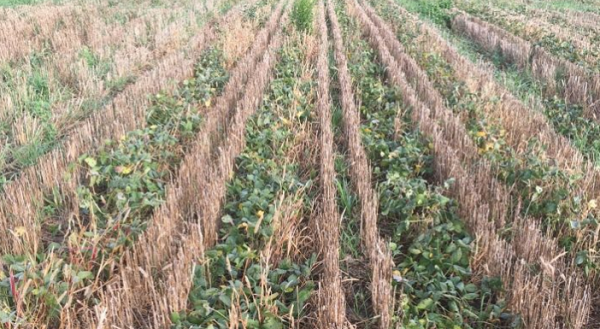
This is the question that Mark Burnham near Coburg and several other growers across Ontario are trying to answer. It can be a challenge for many grain growers to justify the returns of winter wheat in a cash crop rotation, so these innovative growers are experimenting with different ways to continue growing wheat profitably.
Several growers are experimenting with relay cropping where soybeans are planted between rows of winter wheat in the spring with the goal to harvest two cash crops in the same year. The objective is to minimize the winter wheat yield loss, while establishing a soybean crop that will continue to grow after the winter wheat is harvested. The benefits of winter wheat-soybean relay cropping are 1) including winter wheat in rotation to provide a living soil cover through fall, winter and early spring 2) greater crop diversity that has shown to lead to greater soil health and 3) two crops in one year. The challenge is this: will soybeans inter-seeded into established winter wheat pay? That’s the question Mark and other farmers are trying to answer with some on-farm trials this year.
In the fall of 2017, Mark planted winter wheat in three different row spacing configurations; 1)twin rows – 2 rows of wheat and 2 open rows (Figure 1), 2) winter wheat planted in15 inch row spacing (Figure 2) and 3) three-7.5 inch rows of winter wheat with one open 7.5 inch row for soybeans to be planted in spring. The yield of winter wheat was compared to a solid (7.5 inch row spacing) winter wheat stand. Soybeans were planted on 30 inch row widths in the Twin and 3:1 row stands, and in 15 inch row spacing between each wheat row in 15 inch row spacing. The wheat and soybeans were seeded at the same seeds per foot of row for all row configurations.
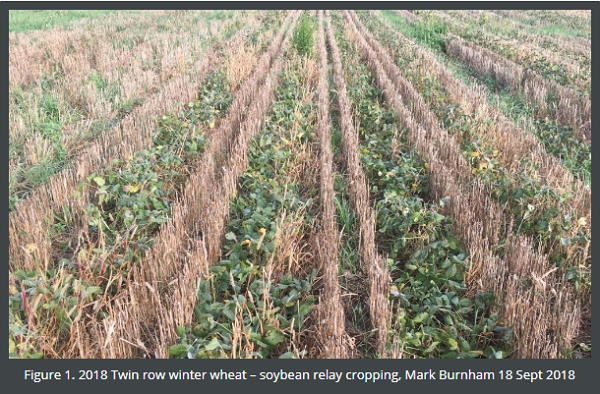
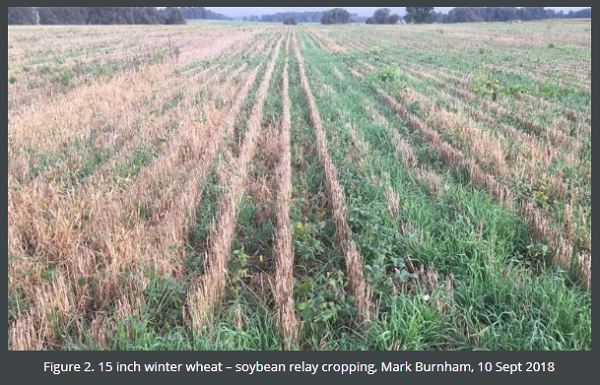
It is well known that there is competition between crops or between plant species. Consequently, we have to wonder: just how much impact is there on the winter wheat yield? How much of an impact is there on the soybean yield? Table 1 shows that in Mark’s plots the wheat yield was reduced by 5-16% depending on the different spacing of the wheat with interseeded soybeans in the 2018 winter wheat crop. It is possible that increasing the plant population to compensate for the wider row spacing may minimize the wheat yield reduction.
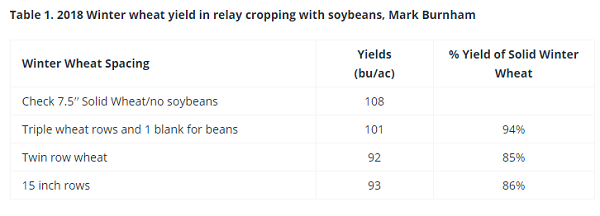
The soybeans have not been harvested at this point to report yields. Based on current market price for winter wheat and soybeans, it would take a yield of about 33 bushel of soybeans per acre to break even in this trial.

There are many challenges to managing two crops together in one season:
- Weed control – it is extremely important to avoid competition with the seedling soybeans and for moisture. Some growers have had good success with a one pass fall application pre-emerge in the winter wheat crop, but generally weed pressure is higher in wider rows of winter wheat.
- Plant competition – in 2018, July was a very dry month, which was stressful on the soybeans competing with the wheat for moisture.
- Stand population – winter wheat is known to tiller well, but increasing the in-row plant population may compensate for the reduced wheat yield. In this year, the winter wheat was seeded at the same rates of seeds per row in each relay cropping configuration.
- Soybean populations – more work needs to be done to look at optimum plant populations for soybeans as it pertains to relay cropping.
- Harvesting winter wheat – shields are required to prevent the cutter-bar from cutting the soybeans and the combine tires need to align with the wheat rows to avoid trampling the soybeans (Figure 3). It is also important to adequately spread straw and chaff so that the remaining soybeans are not smothered.
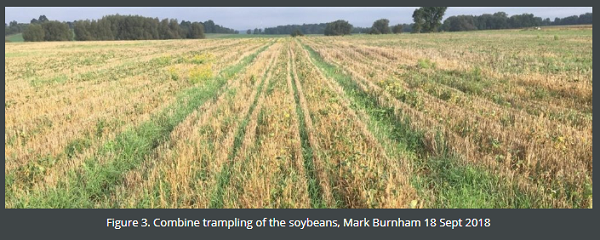
There is still a lot to be learned. Mark is coordinating a relay cropping project funded through the Ontario Soil & Crop Improvement Association’s Tier II grants. Other growers involved in this project include Reuben DeJong, Travis Greydanus, Mike Strang and Rick Kootstra. They are looking for other growers interested in experimenting with relay-cropping. Thank you to Mark and other growers for sharing your results and experiences with relay cropping.
Source : OMAFRA